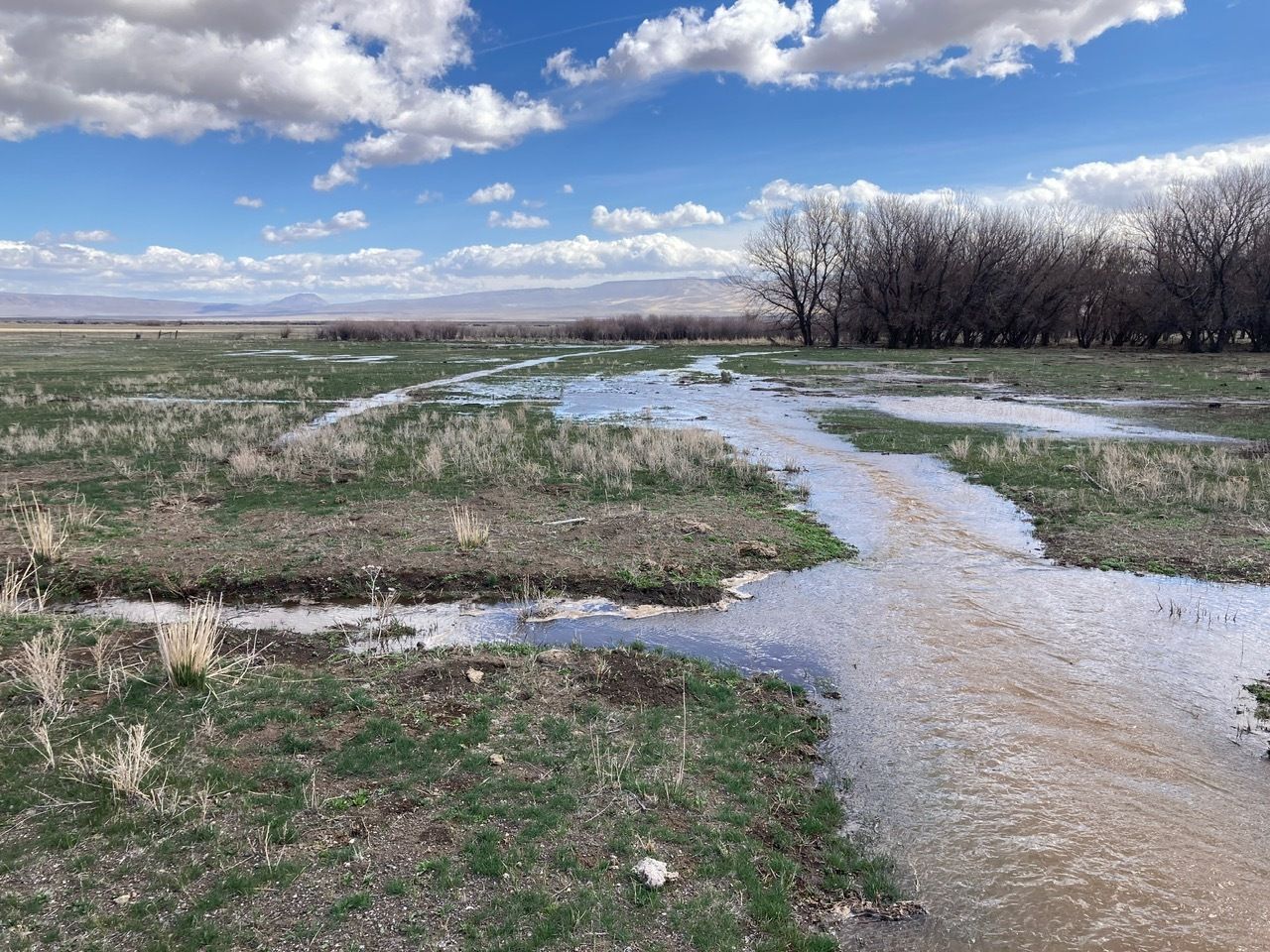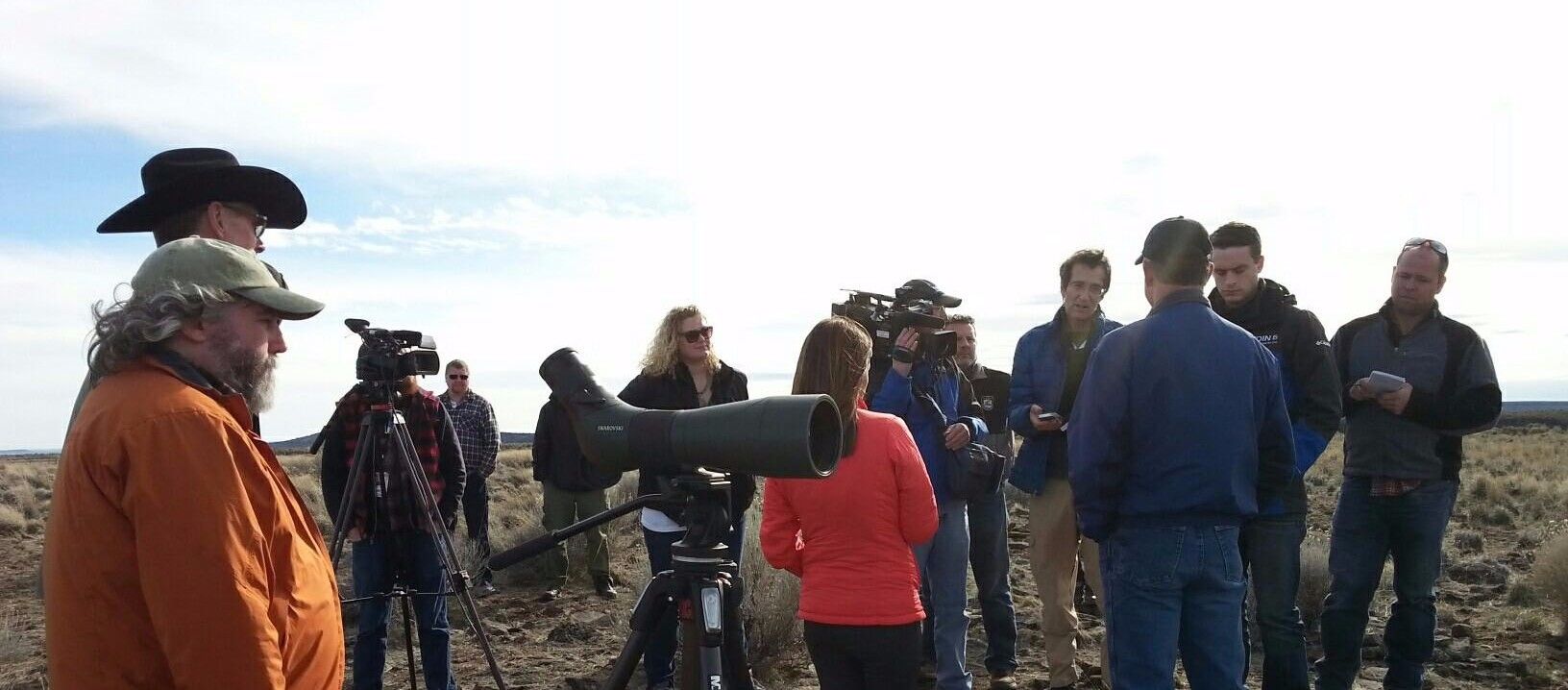
Throughout the Harney Basin there are many water diversion structures in need of repair or replacement to spread water more efficiently and meet state safety and fish passage requirements. High Desert Partnership’s Harney Basin Wetlands Collaborative has been a vital part of identifying these projects and seeing them to completion. A recent infusion of legislative funds has made it possible to get even more work done.
Fields Irrigation Projects
Landowners in the southern part of Harney County contacted Sam Artaiz, SONEC (Southern Oregon Northeast California) Partner Biologist who works with both the Harney Soil & Water Conservation District and the Harney District Natural Resources Conservation Service, regarding the repair/replacement of outdated water diversion structures, and he was able to present those projects before the partners of the Harney Basin Wetlands Collaborative to get them paid for through legislative funds earmarked for the Harney Basin.
As a result, the landowners benefit from projects by spreading water more efficiently without the major expense to their budgets and wildlife and birds benefit through improved habitat.
The Fields Irrigation Projects involve three different projects: The Trout Creek Diversion Project, the Casey Wet Meadows Project and the Colony Creek Project.
The Trout Creek Diversion Project was the first project about which a landowner reached out to Artaiz regarding a replacement. “When I went down to do a site visit, I ran into four different landowners that utilize that structure,” Artaiz said. As he went about getting this project funded, one of the landowners asked if he could return to look at some other structures that needed replacement. This is how the Casey Wet Meadows Project came about.
“The Trout Creek Diversion splits the river into the north and south branch,” Artaiz said. “The Casey structures are both on the south branch and the north branch.” He noted that these are small structures in comparison as the stream in this section of the creek is about 8 feet wide. “A running jump can get you across,” Artaiz said. All these structures are checking turnout structures and do not currently have fish passage. The goal is to replace the dilapidated structures and provide passage for a fish called the Alvord chub.
Since these projects were initiated, other landowners in the area have reached out regarding other projects. “It’s a project that is blossoming as it goes, “Artaiz said. “I wouldn’t be surprised if we get more interest from other landowners for more structures being replaced there.”
The Colony Creek Wet Meadows project is a system wide flood irrigation infrastructure and was also a project initiated by a landowner. The current structure is essentially a bunch of ditches that move water. Over time, the ditches have blown out as a result of torrential flows coming from the nearby mountains. The goal for this project is to engineer control structures that allow users to flood irrigate whether it is a low water year or a high water year. “They will have spill ways that really only open up when the water gets to a certain torrential flow and this allows them to maintain the structures of their ditches without them being eroded but also when that level of flow is reached, they will be able to spread it out without any damage occurring to their structures,” Artaiz said.
All these projects strive to maintain abundant, diverse and resilient wetlands in the face of climatic and anthropomorphic influences to enable a strong natural resource-based economy capable of meeting ecological, community and economic needs. They will do this by replacing dilapidated structures to address improving wet meadow and instream fish habitat while promoting a resource-based economy.
However, the other goal that Artaiz articulated is that these projects also serve to maintain and enhance conversations with the community. These were projects that landowners identified and initiated by contacting him. “Maintaining the momentum of these projects with grant funding and implementation may increase the leveraging ability with other state/federal funds,” Artaiz stated in his project summary analysis.
Irrigation Ditch Pilot Program
Another project Artaiz is working on is the Irrigation Ditch Pilot Program. Maintaining irrigation ditches was something that came up repeatedly in Artaiz’s conversations with landowners and partners within the wetlands collaborative.
While ditch maintenance might not seem like a big project, it can be expensive. “It really depends on the structure and how you’re doing it,” Artaiz said. “If you’re constantly driving your tractor around your field, and you have the implement on your tractor and you have a five-year plan of hitting all your ditches, you’re fine. But that really depends on whether you have the budget to run your tractor for a certain number of hours a year.” Tractors can have maintenance issues. Smaller implements may break. Landowners might have other more pressing issues that need attention. Vegetation such as tules or willows can grow in the meantime. “There is this timeline for this maintenance, but do you have the hours in the day to run it? There are ditches that fall into that wayside. They’re not priorities for that landowner, but they may be a priority for someone downstream,” Artaiz said.
Also, some ditches fall into a gray area of whose responsibility it is to maintain. “If a landowner isn’t getting water directly from a ditch, it’s just a conveyance ditch. How does that affect their willingness to maintain it?” Artaiz said.
He noted that irrigation ditch maintenance can be exempt from a lot of the fill/removal state permits, so they are a lot easier to work on than a larger system that would require a fill/removal permit. The pilot program will help determine how much irrigation ditch maintenance is needed within the county and examine the protocol for cleaning a ditch.
While contractors could use a V-ditcher to complete the maintenance, Artaiz said they are looking to be a bit more exact in their work. The program will require that contractors have an elevation measurer on their machines. Because of how flat the landscape is, a foot one way or the other can really have an impact on how quickly the water moves and how much water is needed to flood irrigate a certain area. “We’re looking to make that elevation a part of the prescription for the cleaning,” Artaiz said. This might mean using excavators that tend to cost more per unit of soil that is moved, but the result is more precise.
Because most of these ditches are irrigating wet meadows that could be classified as wetlands, they also must be cognizant of where the excavated soil is placed. If a landowner doesn’t have berms where the soil can go, they need to have the ability to put the soil off site. “A lot of those funds are earmarked to deal with that soil once it’s pulled out of the ditch,” Araiz said.
The goal is to work on at least three miles of ditch in 2024 and use the rest of the funds for additional miles of ditch in 2025. Projects that take precedence will involve collaboration with multiple landowners.
Cleaner ditches will be able to move water more efficiently so that landowners can get water on their fields sooner and longer.
Rickman Wet Meadows Project
The Rickman Wet Meadows Project is a shovel-ready project; the engineering work is completed. The project will involve obtaining a contractor to procure culverts and install them as well as perform ditch work on flooded wet meadow fields located east of Highway 78 outside of Burns.
This is an example of a project that had all the preliminary work done and was shelved until the necessary funds to complete it were available. Artaiz said that is his goal going forward with most projects: to get all the preliminary engineering and survey work done so that they can be funded when the opportunity presents itself, as it did with the legislative funding.
Ultimately, the Rickman Wet Meadows Project will deliver five water control structures with 3,200 feet of ditch built for 101 acres of flooded wet meadow habitat. It will serve to maintain a wetland ecosystem while creating a resource-based economy associated with flooded habitat for waterbirds.
Again, in this situation, the landowner initially reached out to the Natural Resource Conservation Service, so the goal of working collaboratively with landowners and maintaining community interaction is also one that is achieved with this project.
Updating outdated structures
The next grouping of projects involves updating outdated flood irrigation structures. They are the Riggs Diversion Project, Soldier Creek Wet Meadows Project, Smith Brothers Diversion Project and the Cow Creek Wet Meadows Project. These technical assistance projects require engineering design, surveying and permitting.
“With the funds from the legislature, we’re getting all those projects ready to go,” Artaiz said. “What tends to be the biggest hold up with a lot of projects is engineering costs and permitting and getting that all ironed out.”
The Dunn Dam Project is also grouped in with these projects. It is a shovel-ready project that did not get constructed last fall because the bids for the project were too high.
Some of the issues that come up with project construction involve permits. “Your permits have to be all ready to go otherwise you may lose your building window, and you may have to wait a whole financial year before you can build again,” Artaiz said. “Building time in our area tends to be from August until about November or December.” This is usually the driest part of the year. It’s when ditches are drained, and it’s also when one can get a fill/removal permit to do work in rivers for construction. “You have to time everything for that late summer/fall build,” Artaiz said.
Some of these projects involve replacing instream structures such as push up dams, check dams or other diversion structures. The goal is to replace these outdated structures that are falling apart and replace them with structures that are up to state codes and allow for fish passage if required. Some of the projects are waterway wide structures that are larger and deal with more land, larger water flows and need larger culverts or checking structures to make them work.
All the projects will result in maintaining the flooding of wet meadow habitats, which benefits ranchers and wildlife. By hiring contractors for these projects, it enhances the natural resource-based economy to meet the ecological and economic needs of the community.
As more and more of these structures are replaced, local landowners are seeing the benefits of collaboration, which furthers the conversation and cooperation surrounding the flood irrigation system within the Harney Basin.

